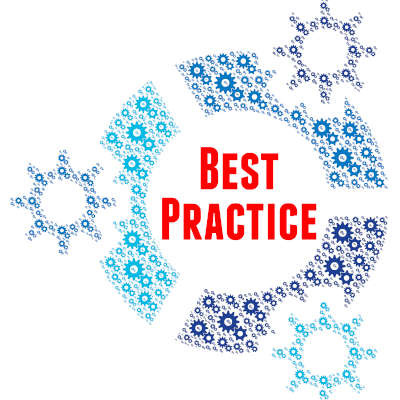Automation has been a business buzzword for some time now, and was a key facet for many businesses remaining open through the COVID-19 pandemic. Now, it seems like there’s no reason for it not to remain in use from this point on. Let’s examine a few ways that automation can and likely will be used moving forward.
Argentum IT LLC Blog
It can be too easy to overlook the importance of technology and its security, particularly in industries that are deeply steeped in tradition, regardless of how crucial that security may seem when actually considered. Just consider the modern law firm, where technology, data, and the security of such is paramount.
If you are a frequent reader of our blog, you will notice that “best practices” is a term that is used generously. That is because there are certain ways to go about things when you are working with technology. Today, we wanted to go over what the term actually means and why they are important when managing your business.
It's no secret that small businesses are facing one of the toughest periods in decades. The COVID-19 pandemic and many other issues have made them change the way they approach operations, sales, and other aspects of their businesses. Today, they need to explore more strategies that can support customers who also have had to adapt. Today, we’ll talk about a couple of the trends we expect to see in IT in 2021.
Social media has turned out to be a culture-defining technology. The massive amounts of people that use the services each week, and the large amount of time people spend on these platforms, makes them important resources for the lion’s share of businesses. The fact that the average user spends around two hours and 24 minutes per day perusing their social media gives businesses opportunities that weren’t available to them only a few short years ago. Today, we thought we would give you a look at how different sizes of SMBs utilize this technology.
If you’re trying to minimize your operating costs to give you more capital to build your business, it is important to keep in mind that sacrifice isn’t your only option. Instead, you also have the option of streamlining and minimizing some of your larger expenses by enlisting a managed services provider (MSP) and the more sustainable business model we adhere to.
If you have been running a business for any length of time, you definitely don’t need to be told how important risk management is. One problem you see from business owners today is that while they understand just how many problems there are--and which ones they need to find solutions for first--they want to grow their company fast, and as a result, they overlook potential problems and end up hurting their business as a result.
The way people talk about cybersecurity, it’s as if it is something like a television or a new phone: something you can just buy. That’s not the truth. When you are seriously looking at how you can keep unwanted entities off your network, while having control over what you do with your technology, you need to look at it as three levels of security.
Disasters, at least in the business sense, have long been underestimated. While you always, always, hear about disasters that are often seen, there are some (as we are witnessing now) that can go under the radar until they strike. Regardless of the nature of the disaster, however, you need to be prepared to continue both your operations and your communications to some degree.
As time passes and technology is developed, a lot of the processes that businesses rely on become more efficient and stand to deliver greater benefits to the organizations that use them. These benefits are accessible to businesses of all sizes, including small businesses. Let’s go over a few small business needs, and how technology can assist with them.
When looking at phone systems for your business, you will immediately notice that Voice over Internet Protocol (VoIP) is more affordable. Gaining extra capital is always nice, but if the VoIP system doesn’t provide the necessary features, what’s the point in switching, right? Lets take a look at some of the benefits VoIP can bring your company.
All businesses demand a certain amount of technology in order to push their organizational profitability forward. Whether they invest in tried-and-true technologies or they use their capital a little more innovatively, really depends on how decision makers’ forecasts of those investments help the organization become more productive or efficient. Today, we will look at five of the most important technology trends for SMBs in 2020.
Technology is trending, there’s no doubt about that, but if you are a decision maker at a small business, technology solutions aren’t typically developed for your business in mind. As a result, it can often be difficult for the SMB to get tools that are scalable enough to make sense for them, while also getting powerful options that will actually work to improve some part of the business. This month, we’ll take a look at three trending technologies that small businesses are starting to use regularly.
Consider something for a moment: aside from their size and the resources at their disposal, what makes a small to medium-sized business so different from a large, enterprise-sized one? If you really consider it, there isn’t all that much. This is why many SMBs have turned to managed services… to receive IT support comparable to what the large businesses get.
As small businesses have to do more with less, they’ve been increasingly looking to technology to fill the gaps. The problem is that many small businesses feel like the big tech companies don’t understand their needs. If you feel like the technology options you have at your disposal don’t necessarily fit your business’ needs, consider that these robust solutions have all the functionality that you need to manage your own business processes. Today, we’ll take a look at some of the enterprise technology SMBs are using to move their businesses forward and some of the considerations you may need to make to leverage a software solution that doesn’t seem like it fits.
In today’s competitive business environment, you need all the help you can get. One of the biggest advantages you can achieve for your business is to take advantage of a trusted and reliable managed IT provider that can give your organization advice on how to navigate the murky waters of the technology world.
For any business to be successful, its inner workings need to be able to work together seamlessly, each with a defined role and purpose. While we usually stick to talking about how to make your IT more collaborative, we’re devoting this week’s tip to ensuring that your employees are also capable of effective collaboration while using these solutions.




















